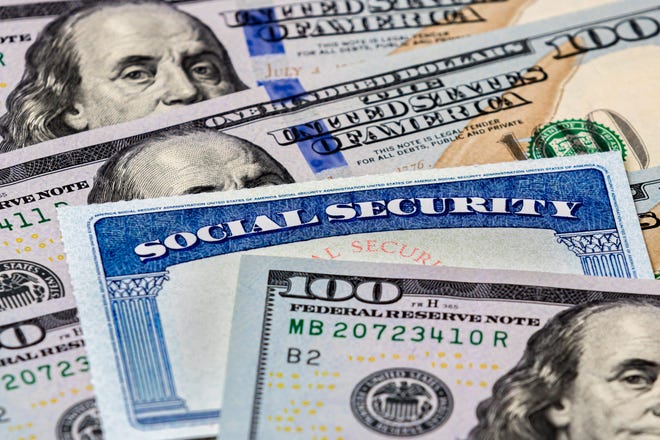
美国社会福利 愈穷愈享白吃的午餐
世界新闻网
12/07/2021

美国是一个福利社会,总体上比较照顾老人和弱势群体,联邦政府为穷人设立的福利项目就有100多种,低收入户和从未纳税奉献国家的新移民,都可以享受「白吃的午餐」!
美国的社会安全金体系主要是为工作过的人们提供退休金养老。每一个工作十年40季的人,在退休后每个月都可以从联邦政府领取社安退休金( Social Security)。另一个重要福利项目则是为没有工作过的老人、残障者提供退休养老金福利,该项目称为社安补助金(SSI)。
美国社会福利另一个重要的方面就是医疗保险(Medicare),在职工作的人们大多由雇主提供医疗保险,因此政府的医疗保险计划主要是为老人和穷人提供的。为老人提供的医疗保险计划涵盖65岁以上老人。联邦政府征收的薪资税项目之一是医疗保险税,等到雇员65岁时就可以享受政府提供的医疗保险。
对于穷人和无收入的人们,联邦和州政府协同设立医疗补助计划(Medicaid),由政府出钱资助他们医疗和看护费用。儿童医疗保险是政府设立的为那些低收入家庭儿童提供医疗保险福利项目。

62岁只能拿75% 「完全退休年龄」可领100%
退休福利(Retirement Benefits)是美国福利制度最重要的部分,企业员工退休以后,绝大多数人的主要经济来源就是政府部门为雇员设立的退休金、联邦医疗保险、残障福利、遗属福利等等。
退休金(social security benefits)是美国员工退休计划的一部分,它为符合条件的退休人员及其家人提供替代收入。从62岁开始可以领退休金,但此时每月只能领到自己退休工资的75%。但是,等到「完全退休年龄(Full Retirement Age)」,便可以领到100%退休金。
Oct 13, 2021
The Social Security Administration (SSA) has just announced the 2022 Cost of Living Adjustment (2022 COLA). This video discusses all the details about this highly controversial number. The video also discloses a poll I ran 10 days ago right here on YouTube asking viewers to “guess the number” (67% OF THE 2700 RESPONDENTS MISSED BY WIDE MARGIN).
什么人才有资格领取退休金?累计十年交税记录并取得40个工作点数,也就是纳税人的收入金额达到该年门槛就可以获得一个点数,每年最多可获得四个点数。如果选择在66-67岁时退休,每个月便可以领取全额联邦退休金。
据美国社安署(Social Security Administration,SSA)网站,现阶段完全退休年龄的计算公式为:出生在1943到1954年,完全退休年龄是66岁;出生在1955到1959年,完全退休年龄在66到67岁之间;如果出生在1960年或之后,完全退休年龄就是67岁。
如果到了完全退休年龄时,也可以选择暂时不领退休金,等到70岁再领取退休金可以拿更多。因为在完全退休年龄以后,每推迟一年领取退休金,金额就能增加8%左右,增加金额的年龄上限为70岁。如果自己的完全退休年龄是67岁,到70岁时才领取退休金就多了24%,以后每月的退休工资都是这个数。
社安署指出,自2010年以来,根据物价指数涨幅,退休金也调升了三次,虽然每次幅度不大。从2019年1月开始,退休人员平均每月可以拿到1503元退休金,2020年全美有近6900万退休者都会享受到这项福利。2022年的生活费用调整(cost-of-living adjustment, COLA)将为5.9%;换算下来,退休人员每月收到的社安金支票平均增加92元,从目前的平均1565元提高到1657元。
社安署统计显示,截止今年9月,申请退休金福利的人数与一年前同期相比,下降约5%,创下近20年来最大幅度。原因在于联邦政府慷慨发放纾困支票,还有额外失业津贴补助,让民众退休之后短时间内不差钱。
社安金不仅仅是退休者本人的社会福利,同时也会惠及配偶和子女。如果退休人员过世,他的配偶若无收入也可领取过世配偶的社安金,但要符合以下的条件:一是配偶的年龄超过50岁、属于残障人士;二是配偶年龄超过60岁;三是不论配偶年龄多大,家中有16岁以下儿童或是残障人士需要抚养。只要符合上述三项条件之一,该遗属即可享受过世配偶的社安金。即使遗属在60岁后再婚,仍符合资格享受过世的前配偶的社安金福利。
如果退休人员过世,其子女也可以享受过世者的社安金,领取条件为:年龄不超过18岁,18至19岁仍在高中读书者,或18至22岁残障人士。如果退休人员生前还要供养父母,而且供养花费占到老人们生活费用的一半以上,在退休者过世后,他或她的父母可以享受领取过世子女的社安金。
如果退休人员生前已离婚,政府规定,只要原配偶的婚姻维持了10年,年龄在60岁以上或是50岁以上但属于残障人士,这名前配偶也有资格领取过世的前配偶的社安金。前配偶没有收入、但需抚养孩子,或前配偶离婚后在60岁前未再婚,符合这两项条件之一,前配偶也可以领取过世的退休者的社安金。
加州发新一轮纾困金 单笔600-1100元
世界新闻网
12/04/2021

加州开始发放80万3000份新一轮纾困金,总额约为5.63亿元。加州税务局媒体联系人勒佩奇(Andrew LePage)表示,最新分发单笔为600-1100元纾困金,共邮寄出80万张纸本支票、3000笔直接汇款给符合条件居民。
加州纾困金计划(Golden State Stimulus II program)自9月初以来持续发放疫情援助款项,直到所有合格纳税人都收到支票。纾困金接受者的家属若符合资格,可获得额外500元。计划经费来自联邦与州府疫情补助款项,适用于2020年纳税申报表中的调整后收入低于7万5000元者。Golden State Stimulus I纾困计划则是为收入低于3万5000元的低收入居民所设置。
问:下一轮纾困金何时发送?
答:11月29日加州开始寄出约80万3000笔纾困金,大部分支票将于11月29日至12月17日寄出、总额约5.63亿元。其中包括80万张总额约5.61亿元的支票、3000笔总额约240万元的直接汇款。直接汇款通常会在数个工作日内出现在银行帐户,也建议民众估计于邮寄支票后的三周时间,可收到纸本支票。
问:迄今已发送多少金额纾困金?
答:11月29日开始处理及邮寄的纾困金付款,已发出或宣布(即目前正在处理寄发至12月17日的纾困金)共约有350万张支票与380万笔直接汇款,两者加总超过51亿元。
问:若纾困金发送遇到问题,可能延后至新年吗?
答:在线邮寄时间表已要求寄出时间可至明年初,部分已于10月15日前申请纳税号码(ITINs)、却尚未收到的人士,将延至2月15日,并仍有资格获得纾困金。
问:加州纾困金支付需纳州税或国税局征税吗?
答:加州不对纾困金征税。另可向国税局询问有关是否需为联邦目的征税。
问:有多少加州人符合资格领取纾困金?
答:粗略预估最终可能接近850万人。
对于尚未收到付款者,可检查调整后净收入额(Adjusted Gross Income ,简称AGI)。美国国税局与加州税务局对纾困金付款有不童的调整后收入资格要求。因此,许多情况下,纳税人可能收到联邦纾困金,但不会收到加州纾困金。搬家或换银行也可能影响是否可顺利收到纾困金。若没有提供直接汇款银行帐户消息,符合条件居民将通过邮件收到纾困金支票。

北美法律公益讲座安排
时间:周二到周五 晚间
5:30-7:00(西部时间)8:30-9:30(东部时间)
周二:如何准备遗嘱材料(遗嘱workshop)
周三:数据泄露和个人身份保护&事业机会说明会
周四:家庭法和婚姻法(周律师)
周五:人身伤害和索赔(朱律师)
Zoom:6045004698,密码:请私信或群里@我
另外:周三6:30(西部时间)
专题:99%华人移民不知道的法律问题(粤语专场)
Zoom 95190929213,密码:私信或群里@我

California stimulus checks: 784,000 new payments to be sent out
By Mary Stringini
11/12/2021
More California stimulus checks to be mailed out on Friday
More California stimulus checks are expected to go out on Friday.
The state’s Franchise Tax Board will send some 748,000 stimulus checks to qualifying residents who filed paper tax returns this year, though a few thousand payments will be direct deposits too.
The $600 payments are part of the Golden State Stimulus II program (GSS II). The second round of stimulus checks for California residents is part of Gov. Gavin Newsom’s $100 billion budget that he signed into law in July. As part of the plan, the state expects to provide about $12 billion in coronavirus relief to 15.2 million California households – or about two-thirds of the state’s taxpayers.
“The Golden State Stimulus is key to lifting up those hit hardest by the pandemic and supporting California’s economic recovery, putting money directly in the hands of folks who will spend it on basic needs and within their local communities,” Newsom said in a statement at the time.
Eligible recipients include current California residents who lived in the state for more than half of the 2020 tax year and individuals who earned $75,000 or less in 2020.
Roughly 34,000 direct deposit payments will go out beginning Friday, Nov. 12. By Monday, Nov. 15, 750,000 GSS II checks will hit the U.S. Postal Service. The state’s Franchise Tax Board said that it could take checks up to three weeks to arrive in mailboxes.
Payments will go out by the last 3 digits of the ZIP code on your 2020 tax return.
The state released the following timeframes for qualifying recipients to expect their payments by mail based on the last three digits of their ZIP code:
- 000-044 10/06/2021 through 10/27/2021
- 045-220 10/18/2021 through 11/05/2021
- 221-375 11/1/2021 through 11/19/2021
- 376-584 11/15/2021 through 12/03/2021
- 585-719 11/29/2021 through 12/17/2021
- 720-927 12/13/2021 through 12/31/2021
- 928-999 12/27/2021 through 1/11/2022
To check your status and get an estimate on the amount of stimulus money you qualify for, you can go to www.ftb.ca.gov.
Social Security cost-of-living increase will boost benefits 5.9% in 2022 as inflation spikes
By Paul Davidson | USA TODAY
10/13/2021
Now that’s more like it.
Older Americans scraping by on meager increases in their Social Security checks the past decade will reap a relative windfall next year.
The roughly 70 million people – retirees, disabled people and others – who rely on Social Security will receive a 5.9% cost-of-living adjustment next year, the Social Security Administration said Wednesday. That’s the biggest bump since 1982.
The sharp increase is tied to a COVID-19-fueled spike in inflation after years of paltry consumer price increases.
For the average retiree who got a monthly check of $1,565 this year, the bump means an additional $92 a month in 2022, boosting the typical payment to $1,657.
“The guaranteed benefits provided by Social Security and the COLA increase are more crucial than ever as millions of Americans continue to face the health and economic impacts of the pandemic,” AARP CEO Jo Ann Jenkins said in a statement. “Social Security is the largest source of retirement income for most Americans and provides nearly all income (90% or more) for one in four seniors.”

SSA bases its cost-of-living adjustment on average annual increases in the consumer price index for urban wage earners and clerical workers, or CPI-W, from July through September. The CPI-W largely reflects the broad CPI that the Labor Department releases each month.
On Wednesday, Labor said the CPI-W rose 5.9% annually in September following a 5.8% jump in August.
The COLA has averaged 1.4% the past 10 years – half the average over the prior decade – because of unusually low inflation, according to the Senior Citizen League, an advocacy group.
During this period, tens of millions of Social Security beneficiaries saw much or all of their cost-of-living increases effectively erased because of sharply climbing premiums for Medicare Part B, which are automatically deducted from many Social Security checks.
That shouldn’t be the case for most recipients this year because of the healthy COLA advance. The Part B premium is set to rise by $10 and prescription drug plan premiums are likely to increase an average of about 5%, says Mary Johnson, a policy analyst for the Senior Citizen League.
Johnson has long complained that the basket of goods that determines the CPI-W index doesn’t reflect the spending patterns of seniors who buy less gasoline, electronics and other products that make up a big portion of younger workers’ spending. Seniors instead spend more on food, health care costs and other items that have seen sharp price increases during the pandemic.
Johnson has called for the SSA to base its COLA on a proposed index for the elderly called CPI-E that would put more weight on health, food and other expenditures.
Since 2000, Social Security recipients have lost 32% of their buying power as COLAS grew by about half as much as the cost of goods and services typically purchased by retirees, according to the league.
With energy prices soaring this year, part of that dynamic is being reversed, with seniors, who don’t buy as much gasoline, poised to gain from the large COLA increase.
“They’re getting the benefit of that,” Johnson says.
At the same time, older Americans will still face sharply higher costs for some goods and services, including food, rent and prescription drugs. Seniors also could be socked by a 21% to 25% surge in home heating oil and natural gas costs this winter, according to the league and the U.S. Energy Information Administration.
“Retirees have been pummeled by the rising cost of health care, and the CPI-W does not accurately reflect how much retirees are spending on health care,” says Rhian Horgan, CEO of Silvur, maker of a retirement planning app.
Although the COLA bump could somewhat narrow Social Security recipients’ longstanding shortfall in buying power, “it’s not going to restore it,” to 2000 levels, Johnson says.
“While the high COLA is welcome, we have received hundreds of emails from retired and disabled Social Security recipients who say that the low COLAs in recent years have not kept pace with their rising costs,” Johnson says. “That has made it more difficult for many to cope with the rampant inflation of 2021.”
And, she says, the more generous payment will subject some recipients to new taxes or bump them into a higher tax bracket, offsetting some or all of the increase.
Also, many economists are forecasting high inflation again next year as supply chain bottlenecks continue to drive up product costs while labor shortages push employee wages, and related prices, higher.
“The COLA is paying for inflation from last year,” Johnson says. “Not,” she adds, “for future years.”
Six Spaces Home Staging

Contact: Hongliang Zhang
Tel: 571-474-8885
Email: zhl19740122@gmail.com
Federal Communications Commission
Emergency Broadband Benefit

The Emergency Broadband Benefit is an FCC program to help families and households struggling to afford internet service during the COVID-19 pandemic. This new benefit will connect eligible households to jobs, critical healthcare services, virtual classrooms, and so much more.
About the Emergency Broadband Benefit
The Emergency Broadband Benefit will provide a discount of up to $50 per month towards broadband service for eligible households and up to $75 per month for households on qualifying Tribal lands. Eligible households can also receive a one-time discount of up to $100 to purchase a laptop, desktop computer, or tablet from participating providers if they contribute more than $10 and less than $50 toward the purchase price.
The Emergency Broadband Benefit is limited to one monthly service discount and one device discount per household.
Who Is Eligible for the Emergency Broadband Benefit Program?
A household is eligible if a member of the household meets one of the criteria below:
- Has an income that is at or below 135% of the Federal Poverty Guidelines or participates in certain assistance programs, such as SNAP, Medicaid, or Lifeline;
- Approved to receive benefits under the free and reduced-price school lunch program or the school breakfast program, including through the USDA Community Eligibility Provision in the 2019-2020 or 2020-2021 school year;
- Received a Federal Pell Grant during the current award year;
- Experienced a substantial loss of income due to job loss or furlough since February 29, 2020 and the household had a total income in 2020 at or below $99,000 for single filers and $198,000 for joint filers; or
- Meets the eligibility criteria for a participating provider’s existing low-income or COVID-19 program.
How to Apply
The online application for the Emergency Broadband Benefit Program is experiencing high demand. We appreciate your patience as we actively work to resolve any connectivity issues users may encounter.
Apply Now
There are three ways for eligible households to apply:
- Contact your preferred participating broadband provider directly to learn about their application process.
- Go to GetEmergencyBroadband.org to apply online and to find participating providers near you.
- Call 833-511-0311 for a mail-in application, and return it along with copies of documents showing proof of eligibility to:
Emergency Broadband Support Center
P.O. Box 7081
London, KY 40742
After receiving an eligibility determination, households can contact their preferred service provider to select an Emergency Broadband Benefit eligible service plan.
Get More Consumer Information
Check out the Broadband Benefit Consumer FAQ for more information about the benefit.
Which Broadband Providers Are Participating in the Emergency Broadband Benefit?
Various broadband providers, including those offering landline and wireless broadband, are participating in the Emergency Broadband Benefit. Find broadband service providers offering the Emergency Broadband Benefit in your state or territory.
Broadband providers can find more information about how to participate here.
Source: https://www.fcc.gov/broadbandbenefit
Evictions During COVID-19: Landlords’ Rights and Options When Tenants Can’t Pay Rent
Tips, resources, and advice for landlords whose tenants aren’t able to pay the rent due to the coronavirus outbreak.
By Ann O’Connell, Attorney
11/01/2020
Many renters are facing financial challenges resulting from coronavirus-related business shut-downs, furloughs, layoffs, and stay-at-home orders. The longer this crisis goes on, the more likely it is that many will not be able to pay their rent. When renters default on rent, landlords suffer, and might not be able to meet their own financial obligations, such as making the mortgage payments on the rental property.
Here are some suggestions about how landlords can mitigate the financial impact of tenant defaults during the COVID-19 outbreak.
Terminations and Evictions
Under normal circumstances, when tenants don’t pay rent, landlords have the option of terminating the tenancy (by serving the tenant with either a pay rent or quit notice or an unconditional quit notice, depending on the applicable laws). When tenants don’t pay the rent or move out by the deadline given in the notice, landlords can then file an eviction lawsuit to have the tenants physically removed from the rental.
However, health and safety concerns due to COVID-19 have led many states, cities, counties, and courts to place moratoriums on evictions. The scope of these temporary bans on evictions varies greatly: some have banned any and all action relating to evictions, while others simply postpone hearings on evictions until the court can arrange a hearing via telephone or video.
If you are a landlord in an area with an eviction moratorium, you might still be able to file eviction papers with the court, but your case might not be heard for a while. However, even if there are no bans in place, evicting tenants who can’t pay the rent due to the coronavirus crisis probably shouldn’t be your first recourse. Aside from optics (you don’t want to get a reputation as the ruthless landlord who booted tenants out of their home in the middle of a stay-at-home order), if you remove tenants right now, you’re going to be faced with having to disinfect the rental, advertise the rental, screen new prospective tenants (of which there might be very few), sign a new lease or rental agreement, and get the new tenants moved in—all while taking measures to abide by emergency guidelines and health and safety measures.
Consider the following options instead.
Evaluate Your Personal Financial Situation
Take a moment to evaluate your own finances. As dire as it sounds, it might be time to take stock of what could happen in a worst-case scenario. Most landlords have likely considered the situation where tenants don’t pay rent, as this can happen at any time. But there’s no denying that this is a different situation—what will happen if your tenants can’t pay for a long time, and your options for finding new (paying) tenants are slim?
Your assessment of how this worst-case scenario will affect your ability to pay your mortgage (if any) and your personal bills will inform how you respond when your tenants can’t pay their rent.
- If your financial situation looks grim: If your ability to pay the mortgage on your rental property hinges on month-to-month rental income, you should take actions to prevent your own default This includes options discussed below, such as contacting your lender and proactively seeking arrangements with tenants that allow them to make at least partial payments.
- If you have a few months’ reserves: If your personal reserves or financial position won’t feel too much of a pinch if tenants aren’t able to pay rent for a while, you still might have to make some compromises to retain good tenants. If you have tenants who have previously been reliable and are simply finding it hard to make ends meet currently, do what you can to take some pressure off them—see the discussion below about working out a temporary solution with tenants.
Try to Work Out a Temporary Solution With Tenants
Depending on how desperately you need to receive income from your rental, you have a few options for working with tenants who aren’t able to pay rent because of COVID-19. Consider the following possible arrangements.
- Forgive rent. If your situation allows for it, you could waive rent for a month, with an agreement to revisit the payment arrangement on a certain date. A landlord in Bakersfield recently did this for his tenants.
- Postpone rent. You could offer to postpone rent payments for a month, with an agreement that it will be repaid. Your repayment arrangement could state that the rent owed could be spread out over time, paid all at once, or paid when (if) a stimulus check
- Reduce rent. If you can, consider dropping the rent temporarily to a level that enables you to meet your obligations but forgoes profit for the time being. For example, if you normally collect $1200 a month, but your mortgage is $900 a month, you could temporarily drop rent to $900 to make sure you at least don’t get in trouble with your lender.
Before deciding to make any of these adjustments, try talking to your tenants. Ask them straight out what they think they can make work. If you’re able to accommodate their suggestions, chances are higher that they will do everything they can to hold up their end of the bargain. Be sure to put any agreements in writing, preferably as an addendum to your current lease or rental agreement that includes all details of the arrangement.
Look for Outside Assistance
Even if you think you can float a month or two without rental income, you still might want to consider taking some measures now to protect your position in the event that the coronavirus crisis lasts longer than your cushion can handle. If you’re already feeling the pinch, take these actions immediately.
Attend to Your Mortgage
At this point in the COVID-19 crisis, most private lenders are willing to work with borrowers to ensure that they don’t lose their homes. Call your lender directly and ask what steps it is taking to assist borrowers who can’t meet their mortgage obligations due to the coronavirus pandemic.
- If your loan is owned by Fannie Mae or Freddie Mac, you might be able to delay making payments for a certain period of time without incurring late fees or getting hit with a credit score penalty.
- Look into your options under the Coronavirus Aid, Relief, and Economic Security Act.
- The Federal Housing Administration (FHA) has put in place a foreclosure moratorium for single family homeowners with FHA-insured mortgages.
- Visit your state’s website to find out if the state is offering assistance to homeowners. For example, New York has announced a delay of mortgage payments for 90 days. Many other states are postponing any foreclosure actions indefinitely. Find your state’s website at State and Government on the Net.

Look Into Property Tax Breaks
Some states and counties are extending the deadline for paying property taxes, or cancelling late fees and interest. Check your county’s tax assessor’s website to see if this is an option where your property is located.
Seek a Loan
Consider seeking a loan from family, friends, or private lenders. The U.S. Small Business Administration might be another source of assistance—its disaster loan assistance web page has a wealth of information. You can also contact your regular bank or credit union and inquire about what assistance it can offer.
Research Options for Your Renters
Some areas are beginning to offer rent vouchers or emergency funds to renters in need. For example, the Pennsylvania Apartment Association is collecting donations for funds to give to renters who can’t pay rent. Currently, renters’ needs are getting a lot more attention in the press than landlords’ needs, and there are already a lot more resources being made available for renters. It’s in your best interest to research these options and bring them to your renters’ attention—do what you can to help your tenants pay you.
Landlords are getting squeezed between tenants and lenders
By ANNE D’INNOCENZIO

NEW YORK (AP) — When it comes to sympathetic figures, landlords aren’t exactly at the top of the list. But they, too, have fallen on hard times, demonstrating how the coronavirus outbreak spares almost no one.
Take Shad Elia, who owns 24 single-family apartment units in the Boston area. He says government stimulus benefits allowed his hard-hit tenants to continue to pay the rent. But now that the aid has expired, with Congress unlikely to pass a new package before Election Day, they are falling behind.
Heading into a New England winter, Elia is worried about such expenses as heat and snowplowing in addition to the regular year-round costs, like fixing appliances and leaky faucets.
Elia wonders how much longer his lenders will cut him slack.
“We still have a mortgage. We still have expenses on these properties,” he said. “But there comes a point where we will exhaust whatever reserves we have. At some point, we will fall behind on our payments. They can’t expect landlords to provide subsidized housing.”
The stakes are particularly high for small landlords, whether they own commercial properties, such as storefronts, or residential properties such as apartments. Many are borrowing money from relatives or dipping into their personal savings to meet their mortgage payments.
The big residential and commercial landlords have more options. For instance, the nation’s biggest mall owner, Simon Property Group, is in talks to buy J.C. Penney, a move that would prevent the department store chain from going under and causing Simon to lose one of its biggest tenants. At the same time, Simon is suing the Gap for $107 million in back rent.
Michael Hamilton, a Los Angeles-based real estate partner at the law firm O’Melveny & Myers, said he expects to see more retail and other commercial landlords going to court to collect back rent as they get squeezed between lenders and tenants.
Residential landlords are also fighting back against a Trump administration eviction moratorium that protects certain tenants through the end of 2020. At least 26 lawsuits have been filed by property owners around the country in places such as Tennessee, Georgia and Ohio, many of them claiming the moratorium unfairly strains landlords’ finances and violates their rights.
Apartment dwellers and other residential tenants in the U.S. owe roughly $25 billion in back rent, and that will reach nearly $70 billion by year’s end, according to an estimate in August by Moody’s Analytics.

An estimated 30 million to 40 million people in the U.S. could be at risk of eviction in the next several months, according to an August report by the Aspen Institute, a nonprofit organization.
Jessica Elizabeth Michelle, 37, a single mother with a 7-month-old baby, represents a growing number of renters who are afraid of being homeless once the moratorium on evictions ends.
The San Francisco resident saw her income of $6,000 a month as an event planner evaporate when COVID-19 hit. Supplemental aid from the federal government and the city helped her pay her monthly rent of $2,400 through September. But all that has dried up, except for the unemployment checks that total less than $2,000 a month.
For her October rent, she handed $1,000 to her landlord. She said her landlord has been supportive but has made it clear he has bills to pay, too.
“I never had an issue of paying rent up until now. I cry all night long. It’s terrifying,” Michelle said. “I don’t know what to do. My career was ripped out from under me. It’s gotten to the point of where it’s like, ‘Am I going to be homeless?’ I have no idea.’”
Some landlords are trying to work with their commercial or residential tenants, giving them a break on the rent or more flexible lease terms. But the crisis is costing them.
Analytics firm Trepp, which tracks a type of real estate loan taken out by owners of commercial properties such as offices, apartments, hotels and shopping centers, found that hotels have a nearly 23% rate of delinquency, or 30 days overdue, on their loans, while the retail industry has a 14.9% delinquency rate as of August.
The apartment rental market has so far navigated the crisis well, with a delinquency rate of 3%, according to Trepp. That’s in part because of the eviction moratorium, along with extra unemployment benefits from Washington that have since expired.
“There are bad actors, but the majority of landlords are struggling and are trying to work with a bad situation,” said Andreanecia M. Morris, executive director of HousingNOLA, a public-private partnership that pushes for more affordable housing in the New Orleans area.
Morris, who works with both landlords and tenants, said that government money wasn’t adequate to help tenants pay their rent, particularly in expensive cities. She is calling for comprehensive rental assistance.
She fears that residential landlords will see their properties foreclosed on next year, and the holdings will be bought by big corporations, which are not as invested in the neighborhoods.
Gary Zaremba, who owns and and manages 350 apartment units spread out over 100 buildings in Dayton, Ohio, said he has been working with struggling tenants — many of them hourly workers in restaurants and stores — and directs them to social service agencies for additional help.
But he is nervous about what’s next, especially with winter approaching and the prospect of restaurants shutting down and putting his tenants out of work. He has a small mortgage on the buildings he owns but still has to pay property taxes and fix things like broken windows or leaky plumbing.
“As a landlord, I have to navigate a global pandemic on my own,” Zaremba said, “and it’s confusing.”






